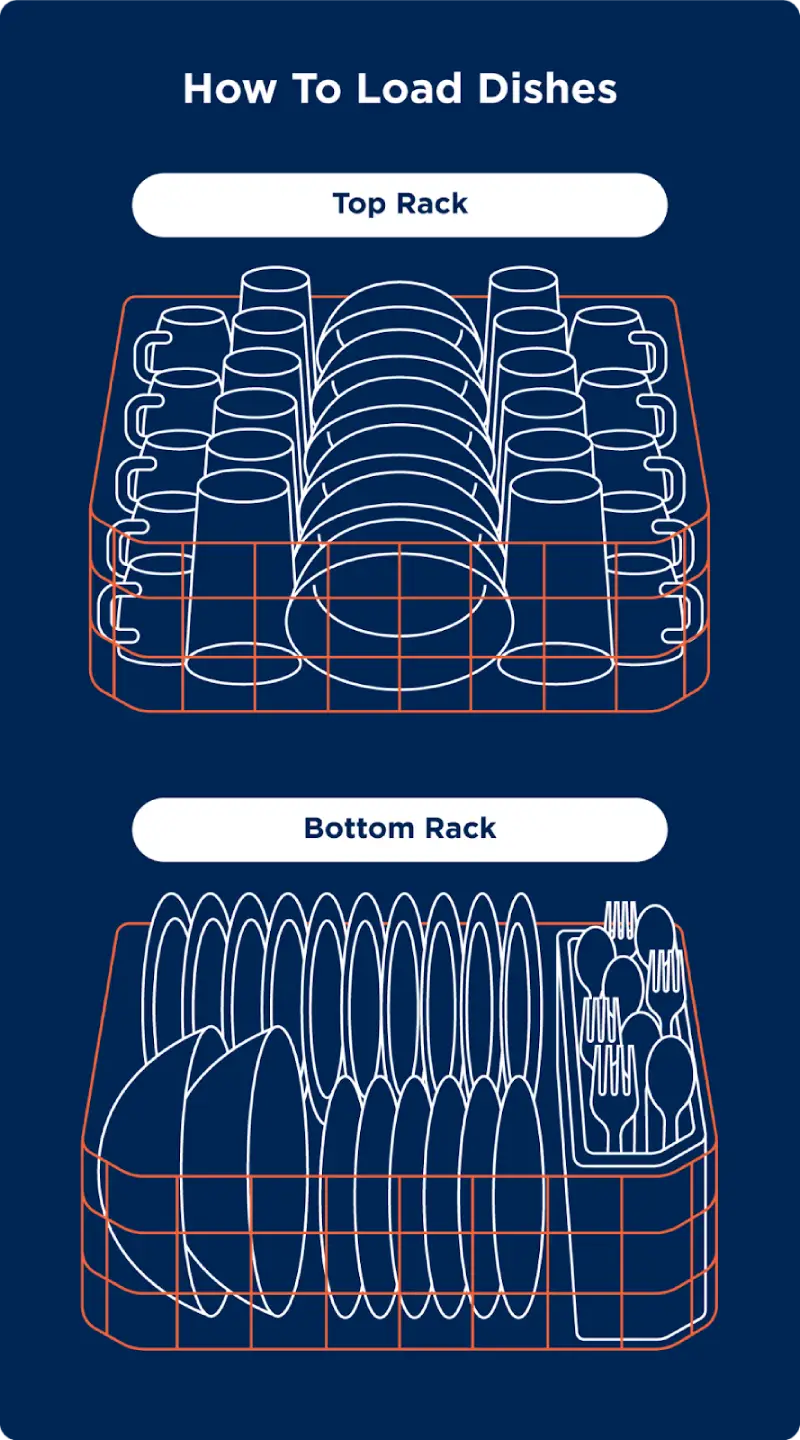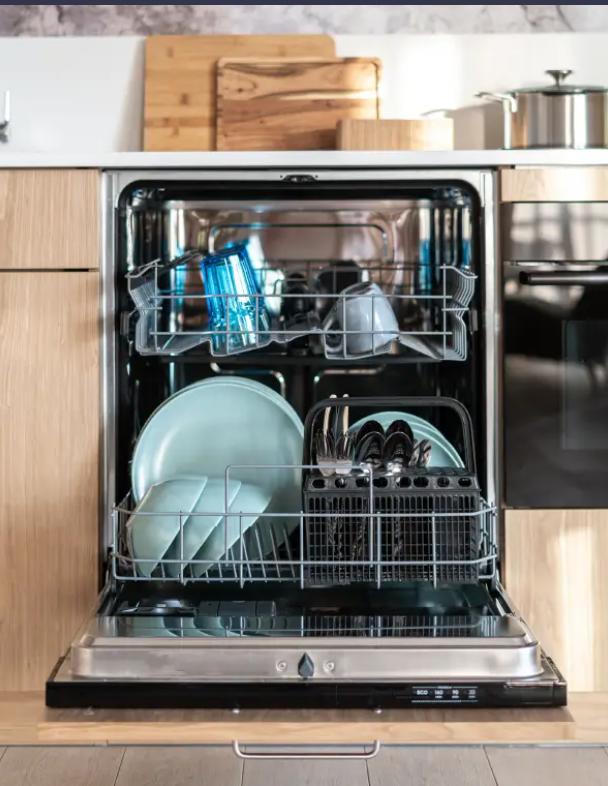How to Load a Dishwasher to Get Cleaner Dishes

Washing dishes is a simple household chore, especially if you have an automatic dishwasher. However, that doesn’t mean your dishes will always come out clean. Whether you have an older machine or a brand new one, your dishwasher was engineered to work in a specific way. Learning how to load a dishwasher will help ensure your dishes are always sparkling clean without the need to wash them by hand or run an extra wash cycle.
Before you begin, review your dishwasher’s owner’s manual to make sure you understand all the settings and check for any special loading instructions. Once you understand the features of your machine, you can use a few simple tricks to ensure clean dishes every time. To help, we’ll share tips and answer a few common questions about how to properly load a dishwasher.
1. Place Dishes, Cups, and Utensils Strategically

Placing your dishes on the correct rack and in the correct positions helps ensure they come out clean. You can strategically place items in the dishwasher by following these five steps:
- Reserve the top rack of the dishwasher for concave items like glasses, cups, and bowls. Make sure all the items in the top rack face down toward the bottom of the dishwasher to maximize cleaning and avoid the accumulation of dirty water.
- To get good water spray coverage inside your bowls, make sure the ones in the back face forward and the ones in the front face toward the back.
- Place large serving utensils that won’t fit in the bottom utensil tray onto the top rack.
- Use the bottom rack for larger pots, bakeware, and flat items like plates, platters, and non-wood cutting boards.
- Make sure large, flat pieces stand up vertically on the sides and in the back of the bottom rack to prevent them from blocking the water spray and the detergent door from opening.
2. Use the Right Settings
Almost all dishwashers manufactured in the last 30 years have settings for different uses. For example, baby bottles and other dishes that need a deep clean will benefit from the sanitized setting. If you have pots with grease or caked-on food residue, look for a pot scrubber or heavy load setting.
When choosing a wash cycle, remember to select the correct cycle for the cleaning you need. Even items labeled as dishwasher safe, like glassware or other delicate dishes, can get damaged if you run them through a wash cycle intended for heavily soiled pots. Here’s an overview of common settings you can choose from:
- Normal wash: the standard wash cycle for everyday dishes and cutlery with an average amount of mess
- Auto wash: cycles that detect the amount of mess on your dishes and automatically adjust the heat and cycle duration to clean them
- Heavy duty: cycles using extra water and heat to clean heavily soiled dishes and larger pots, tableware, and pans
- Quick wash: fast cycles that use extra energy, water, and heat to quickly clean lightly soiled dishes
- Rinse only: rinse cycles that don’t use detergent and lightly wash dishes before a full wash cycle
3. Ensure Hot Water Is Working
The temperature of your water affects whether your dishwasher produces clean dishes. Dishwashers work most effectively when the water temperature reaches 120 degrees Fahrenheit because food stains dissolve best at this temperature.
To check the temperature of your hot water, get a cup and a meat thermometer. Run hot water out of the kitchen tap for a few minutes, fill a small cup, then place the meat thermometer in the water. If the water’s at the correct temperature but your dishes aren’t getting clean, you should call an appliance professional to check your dishwasher.
4. Use Pods
Even if you’re satisfied with liquid or powdered soap in your dishwasher, detergent pods can greatly improve your dishwasher’s cleaning power. These pre-measured gel packs and tablets set a new industry standard. As a result, detergent companies have invested heavily in their performance. Tests conducted by appliance manufacturers, cleaning experts, and industry magazines show that detergent pods clean the best, without leaving behind a soapy film or water spots.
Dishwasher Loading Tips
To get your dishes as clean as possible every wash cycle, keep these tips on how to correctly load a dishwasher in mind:
- Clean your dishwasher once a month: Cleaning your dishwasher removes leftover food waste and ensures every cycle cleans as much as possible. Wipe down the gaskets and run an empty cycle to keep it clean.
- Clean your dishwasher’s filter every three to six months: The dishwasher filter keeps your machine running efficiently by preventing clogs and leaks. Cleaning it a few times a year helps with water filtration and catches food particles that can damage the washer.
- Run wash cycles with distilled white vinegar every three months: Vinegar removes built-up food particles and grease in your washer. Running a vinegar cycle will help your machine operate at its full potential.
- Avoid overcrowding your dishwasher: Overpacking your dishwasher prevents a complete wash from all sides because some items will be blocked by other items in your dishwasher. In some cases, overpacking your dishwasher can lead to leaks or other damage.
- Try not to block the sprayer arms during a wash cycle: Sprayer arms direct the water that is used to wash your dishes. If the water can’t reach everything loaded inside, you’ll have to run another load.
Keep Your Dishwasher in Shape With Mr. Appliance

Learning how to load a dishwasher does more than keep utensils and plates clean. By properly stacking your dishwasher, you can avoid long-term damage and keep your machine in top shape.
However, if your dishwasher gets damaged, your local Mr. Appliance can help. By scheduling service with us online or by phone, we will ensure your dishwasher is in great condition — no matter what type or style of dishwasher you have.
Contact your local Mr. Appliance today for expert appliance repair near you.
FAQ About Loading a Dishwasher
Still, have questions about the finer points of loading a dishwasher? To help you learn how to load a dishwasher properly and avoid having to fix one, we answered a few frequently asked questions.
Can You Wash Any Dishes or Utensils in a Dishwasher?
Before putting anything in your dishwasher, make sure each item is dishwasher safe. Anything valuable or delicate, like crystal, vintage glassware, or gold or silver-trimmed china, needs a hand-wash to avoid damage. The same goes for steak and carving knives. They should never go in the dishwasher. Even plastic or wooden utensils and some non-stick cookware can get damaged if they’re not labeled dishwasher safe.
Do You Need to Pre-Rinse Dishes?
You don’t need to rinse dishes before loading them. While you should scrape off leftover food before loading dishes, your washer can handle stains and small portions of stuck-on food. Some dishwashers use sensors to detect the level of cleaning your dishes need. So, pre-washing them may lead to a less powerful rinse cycle.
How Do You Stack Glasses in the Dishwasher?
Stack your glasses onto the top rack of your dishwasher and place them upside down or on their side. This position will help the glasses drain after getting rinsed. Additionally, keep your glasses apart so they don’t bump into each other or crack.
How Do You Stack a Dishwasher Cutlery Tray?
Lay forks and spoons on their side in a cutlery rack. If you lay the utensils upright, you won’t clean the entire surface. Knives should lie with the blade facing down to avoid cutting yourself when pulling them out. Finally, avoid over-cramming the cutlery basket to ensure every utensil gets a full wash.
 Click to call
Click to call


